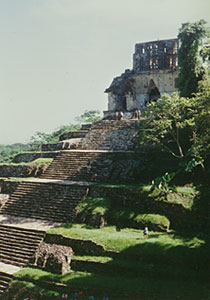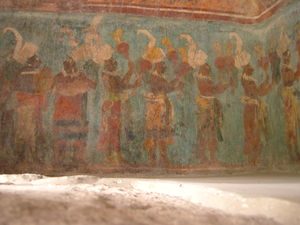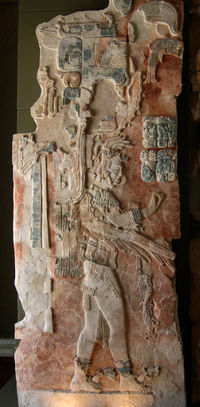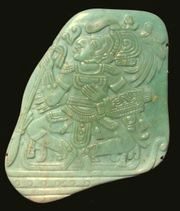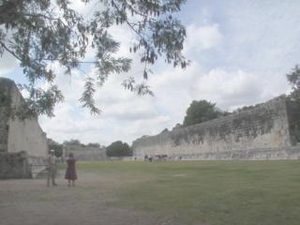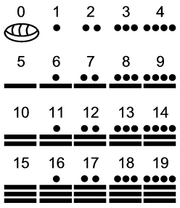|
MAYA
|
|
The Maya civilization is a historical Mesoamerican civilization, which extended throughout the northern Central American region which includes the present-day nations of Guatemala, Belize, western Honduras and El Salvador, as well as the southern Mexican states of Chiapas, Tabasco, and the Yucatán peninsula states of Quintana Roo, Campeche and Yucatán, Gulf of Mexico.
Within this region, elements associated with the Maya civilization have been found which date back to approximately 1000 BC. The region had however been inhabited since at least the 10th millennium BC, and the point at which distinctive Maya-like characteristics first arose is not well-defined. By the period known to archaeologists as the mid-Preclassic (or mid-Formative, around 600 BC), some of the earliest Maya complexes had been constructed. The later Classic period (c. 250 - 900) witnessed the peak of widespread urban center construction and the recording of monumental inscriptions, particularly in the southern lowland regions.
Mayan temple of the inscriptions Palenque with intricate roof comb and corbeled arch
For reasons which are still much debated, many of these sites were abandoned in the Terminal phase of this period (the so-called "Terminal collapse"), although in several places these activities continued, particularly in northern Yucatán. Detailed monumental inscriptions all but disappeared. During the succeeding Post-Classic period (to the early 16th century), development in the northern centers persisted, characterised by an increasing diversity of external influences; however by the time of the Spanish arrival in 1519 most of these centers had substantively declined.
The Maya civilization shared many features with other Mesoamerican civilizations, for there was a high degree of interaction and cultural diffusion throughout the region. Although aspects such as writing and the calendar (see Maya calendar) did not originate with the Maya, their civilization developed these to their fullest extent. Maya influences can be detected as far afield as central Mexico, more than 1000 km from their homelands. Equally, many external influences are to be found in Maya art and architecture, particularly in the Post-Classic period; these are thought to be mainly a result of trade and cultural exchange, rather than direct external conquest.
Contrary to popular perception, the various Maya peoples themselves had not "disappeared", neither at the time of the Classic period decline nor with the arrival of the Spanish conquistadores and the subsequent colonization of their lands. The Maya persist in contemporary Mesoamerican societies, maintaining a distinctive set of traditions and beliefs, albeit generally combined with more recent practices such as widespread adoption of Roman Catholicism. The Maya and their descendants form sizeable populations throughout the region formerly occupied by the states of the ancient civilization. Many different Mayan languages are still spoken as their primary language.
Origins
Archaeological evidence shows the Maya had started to build ceremonial architecture by approximately 1000 BC. There is some disagreement about the boundaries which differentiate the physical and cultural extent of the early Maya and their neighboring Pre-Classic Mesoamerican civilizations, such as the Olmec culture of the Tabasco lowlands and the Mixe-Zoque– and Zapotec–speaking peoples of Chiapas and southern Oaxaca. Many of the earliest significant inscriptions and buildings appeared in this overlapping zone, and evidence suggests that these cultures and the formative Maya influenced one other.
The earliest monuments consist of simple burial mounds, the precursors to pyramids erected in later times. Eventually, the Olmec culture faded after spreading its influence into the Yucatan peninsula, present-day Guatemala, and other regions.
Mayan fresco mural at Bonampak
The Maya developed the famed cities of Tikal, Palenque, Copán and Kalakmul, as well as Dos Pilas, Uaxactun, Altun Ha, Bonampak and many other sites in the area. They developed an agriculturally intensive, city-centered empire consisting of numerous independent city-states. The most notable monuments are the pyramids they built in their religious centers and the accompanying palaces of their rulers. Other important archaeological remains include the carved stone slabs usually called stelae (the Maya called them Tetun, or "Tree-stones"), which depict rulers along with hieroglyphic texts describing their genealogy, war victories, and other accomplishments.
The Maya participated in long distance trade in Mesoamerica and possibly further lands. Important trade goods included cacao, salt, and obsidian; see also: Obsidian use in Mesoamerica.
Political structures
A typical Classic Maya polity was a small kingdom (ajawil, ajawlel, ajawlil) headed by a hereditary ruler – ajaw, later k’uhul ajaw. Both terms appear in early Colonial texts including Papeles de Paxbolón where they are used as synonymous to Aztec and Spanish terms for supreme rulers and their domains – tlahtoani (Tlatoani) and tlahtocayotl, rey or magestad and reino, señor and señorío or dominio. Such kingdom was usually no more than a capital city with its neighborhood and several lesser towns, although there were greater kingdoms, which controlled larger territories and extended patronage over smaller polities. Each kingdom had its name that did not necessarily correspond to any locality within its territory. Its identity was that of a political unit associated with a particular ruling dynasty. For instance, the archaeological site of Naranjo was the capital of the kingdom of Saal. The land (chan ch’e’n) of the kingdom and its capital were called Wakab’nal or Maxam and were part of a larger geographical entity known as Huk Tsuk. Interestingly, despite constant warfare and eventual shifts in regional power, most kingdoms never disappeared from the political landscape until the collapse of the whole system in the ninth century AD. In this respect, Classic Maya kingdoms are highly similar to late Post Classic polities encountered by the Spaniards in Yucatan and Central Mexico: some polities could be subordinated to hegemonic rulers through conquests or dynastic unions and yet even then they persisted as distinct entities.
Mayanists have been increasingly accepting the ‘court paradigm’ of Classic Maya societies that puts the emphasis on the centrality of the royal household and especially the person of the king. This approach focuses on the totality of Maya monumental spaces as the embodiment of the diverse activities of the royal household. It considers the role of places and spaces (including dwellings of royalty and nobles, throne rooms, temples, halls and plazas for public ceremonies) in establishing and negotiating power and social hierarchy, but also in producing and projecting aesthetic and moral values that define the order of a wider social realm.
Spanish sources invariably describe even the largest Maya settlements of Yucatan and Guatemala as dispersed agglomerations of dwellings grouped around the temples and palaces of the ruling dynasty and lesser nobles. None of the Classic Maya cities shows evidence of economic specialization and commerce of the scale of Mexican Tenochtitlan. Instead, Maya cities were in fact enormous royal households, the locales of the administrative and ritual activities of the royal court. They were the places where privileged nobles could approach the holy ruler, where aesthetical values of the high culture were formulated and disseminated, where aesthetic items were consumed. They were the self-proclaimed centers and the sources of social, moral, and cosmic, order. The fall of a royal court as in the well-documented cases of Piedras Negras or Copan would cause the inevitable ‘death’ of the associated settlement.
Mayan stucco relief in the museum at Palenque
Art
Many consider Maya art of their Classic Era (c. 200 to 900 AD) to be the most sophisticated and beautiful of the ancient New World. The carvings and stucco reliefs at Palenque and the statuary of Copán are especially fine, showing a grace and accurate observation of the human form that reminded early archaeologists of Classical civilization of the Old World, hence the name bestowed on this era. We have only hints of the advanced painting of the classic Maya; mostly what have survived are funerary pottery and other Maya ceramics. Also a building at Bonampak holds ancient murals that survived by serendipity. With the decipherment of the Maya script it was discovered that the Maya were one of the few civilizations where artists attached their name to their work.
Architecture
As unique and spectacular as any Greek or Roman architecture, Maya architecture spans many thousands of years; yet, often the most dramatic and easily recognizable as Maya are the fantastic stepped pyramids from the Terminal Pre-classic period and beyond. These pyramids relied on intricate carved stone in order to create a stair-step design. Each pyramid was dedicated to a deity whose shrine sat at its peak. During this "height" of Maya culture, the centers of their religious, commercial and bureaucratic power grew into incredible cities, including Chichen Itza, Tikal, and Uxmal. Through observation of the numerous consistent elements and stylistic distinctions, remnants of Maya architecture have become an important key to understanding the evolution of their ancient civilization. There are also cave sites that are important to the Maya. These cave sites include Jolja Cave, the cave site at Naj Tunich, the Candelaria Caves, and the Cave of the Witch. There are also Origin Cave myths among the Maya. Some cave sites are still used by the modern Maya in the Chiapas highlands.
Urban design
As Maya cities spread throughout the varied geography of Mesoamerica, the extent of site planning appears to have been minimal; their cities having been built somewhat haphazardly as dictated by the topography of each independent location, Maya architecture tends to integrate a great degree of natural features. For instance, some cities existing on the flat limestone plains of the northern Yucatan grew into great sprawling municipalities, while others built in the hills of Usumacinta utilized the natural loft of the topography to raise their towers and temples to impressive heights. However, some semblance of order, as required by any large city, still prevailed.
At the onset of large-scale construction, a predetermined axis was typically established in congruence with the cardinal directions. Depending upon the location and availability of natural resources such as fresh-water wells, or cenotes, the city grew by connecting great plazas with the numerous platforms that created the sub-structure for nearly all Maya buildings, by means of sacbeob causeways. As more structures were added and existing structures re-built or remodeled, the great Maya cities seemed to take on an almost random identity that contrasts sharply with other great Mesoamerican cities such as Teotihuacan and its rigid grid-like construction.
At the heart of the Maya city existed the large plazas surrounded by their most valued governmental and religious buildings such as the royal acropolis, great pyramid temples and occasionally ball-courts. Though city layouts evolved as nature dictated, careful attention was placed on the directional orientation of temples and observatories so that they were constructed in accordance with Maya interpretation of the orbits of the stars. Immediately outside of this ritual center were the structures of lesser nobles, smaller temples, and individual shrines: the less sacred and less important structures had a greater degree of privacy. Outside of the constantly evolving urban core were the less permanent and more modest homes of the common people.
Classic Era Maya urban design could easily be described as the division of space by great monuments and causeways. In this case, the open public plazas were the gathering places for the people and the focus of the urban design, while interior space was entirely secondary. Only in the Late Post-Classic era did the great Maya cities develop into more fortress-like defensive structures that lacked, for the most part, the large and numerous plazas of the Classic.
Mayan jadeite "pectoral", 195mm high
Building materials
A surprising aspect of the great Maya structures is their lack of many advanced technologies that would seem to be necessary for such constructions. Lacking metal tools, pulleys and maybe even the wheel, Maya architecture required one thing in abundance: manpower. Yet, beyond this enormous requirement, the remaining materials seem to have been readily available. All stone for Maya structures appears to have been taken from local quarries. They most often utilized limestone, which remained pliable enough to be worked with stone tools while being quarried, and only hardened once removed from its bed. In addition to the structural use of limestone, much of their mortar consisted of crushed, burnt, and mixed limestone that mimicked the properties of cement and was used just as widely for stucco finishing as it was for mortar. However, later improvements in quarrying techniques reduced the necessity for this limestone-stucco as their stones began to fit quite perfectly, yet it remained a crucial element in some post and lintel roofs. In the case of the common homes, wooden poles, adobe, and thatch were the primary materials; however, instances of what appear to be common houses of limestone have been discovered as well. It should be noted that one instance, in the city of Comalcalco, fired-clay bricks have been found as a substitute to stone because of a lack of substantial stone deposits. Building process
All evidence seems to suggest that most stone buildings existed on top of a platform sub-structure that varied in height from less than a meter, in the case of terraces and smaller structures, to 45 meters in the case of great temples and pyramids. A flight of often steep stone steps split the large stepped platforms on at least one side, contributing to the common bi-symmetrical appearance of Maya architecture. Depending on the prevalent stylistic tendencies of an area, these platforms most often were built of a cut and stucco stone exterior filled with densely packed gravel. As is the case with many other Maya relief, those on the platforms often were related to the intended purpose of the residing structure. Thus, as the sub-structural platforms were completed, the grand residences and temples of the Maya were constructed on the solid foundations of the platforms. As all structures were built, little attention seems to have been given to their utilitarian functionality and much to their external aesthetics; however, a certain repeated aspect, the corbeled arch, was often utilized to mimic the appearance and feel of the simple Maya hut. Though not an effective tool to increase interior space, as it required thick stone walls to support the high ceiling, some temples utilized repeated arches, or a corbeled vault, to construct what the Maya referred to as pibnal, or sweatbath, such as those in the Temple of the Cross at Palenque. As structures were completed, typically extensive relief work was added ... often simply to the covering of stucco used to smooth any imperfections; however, many lintel carvings have been discovered, as well as actual stone carvings used as a facade. Commonly, these would continue uninterrupted around an entire structure and contain a variety of artwork pertaining to the inhabitants or purpose of a building. Though not the case in all Maya locations, broad use of painted stucco has been discovered as well.
It has been suggested that, in conjunction to the Maya Long Count Calendar, every fifty-two years, or cycle, temples and pyramids were remodeled and rebuilt. It appears now that the rebuilding process was often instigated by a new ruler or for political matters, as opposed to matching the calendar cycle. However, the process of rebuilding on top of old structures is indeed a common one. Most notably, the North Acropolis at Tikal seems to be the sum total of 1,500 years of architectural modifications.
Notable constructionsCeremonial platforms
These were commonly limestone platforms of typically less than four meters in height where public ceremonies and religious rites were performed. Constructed in the fashion of a typical foundation platform, these were often accented by carved figures, altars and perhaps tzompantli, a stake used to display the heads of victims or defeated Mesoamerican ballgame opponents.
Palaces
Large and often highly decorated, the palaces usually sat close to the center of a city and housed the population's elite. Any exceedingly large royal palace, or one consisting of many chambers on different levels might be referred to as an acropolis. However, often these were one-story and consisted of many small chambers and typically at least one interior courtyard; these structures appear to take into account the needed functionality required of a residence, as well as the decoration required for their inhabitants stature. Archaeologists seem to agree that many palaces are home to various tombs. At Copán, beneath over four-hundred years of later remodeling, a tomb for one of the ancient rulers has been discovered and the North Acropolis at Tikal appears to have been the site of numerous burials during the Terminal Pre-classic and Early Classic periods.
E-groups
"E-group" is a classification given by Mayanists to certain structure complexes attested in quite a few Maya sites of the central and southern lowlands - Petén region. Complexes of this type consist of a stepped pyramid main structure, which appears without fail on the western side of a quadrilateral plaza or platform. A raised but rather elongated structure appears along the eastern side of the plaza, running north-south; a variation has three smaller temple mounds on top of or replacing this platform, the middle of these substructures placed directly opposite the main structure. Often, two other subsidiary structures appear on the north and south sides of the plaza, respectively. The main western structure is typically terraced (i.e. has several levels), with inset stairways on each of its four sides, with only the eastern stairway (i.e. the one leading from the plaza) providing access to the summit. The stairways have large balustrades which protrude from the pyramid, which were decorated with large stucco masks and panels of architectural art. In other examples (believed to be of a later date) this quadripartite stairway configuration is lacking.
It has been theorized that these E-groups are observatories due to the precise positioning of the sun through the small temples when viewed from the pyramid during the solstices and equinoxes. Other ideas seem to stem from the possible creation story told by the relief and artwork that adorns these structures.
E-group complexes are named after their prototypical example, Structure E-VII-sub at the site of Uaxactun. They were first identified as a meaningful complex by archaeologist Franz Blom in 1924, who excavated the site under the auspices of the Carnegie Institute.
Pyramids and temples
Often the most important religious temples sat atop the towering Maya pyramids, presumably as the closest place to the heavens. While recent discoveries point toward the extensive use of pyramids as tombs, the temples themselves seem to rarely, if ever, contain burials. Residing atop the pyramids, some of over two-hundred feet, such as that at El Mirador, the temples were impressive and decorated structures themselves. Commonly topped with a roof comb, or superficial grandiose wall, these temples might have served as a type of propaganda. As occasionally the only structure to exceed the height of the jungle, the roof combs atop the temples were often carved with representations of rulers that could be seen from vast distances. Beneath the proud temples sat the pyramids that were, ultimately, a series of platforms split by steep stairs that would allow access to the temple.
Observatories
The Maya were keen astronomers and had mapped out the phases of celestial objects, especially the Moon and Venus. Many temples have doorways and other features aligning to celestial events. Round temples, often dedicated to Kukulcan, are perhaps those most often described as "observatories" by modern ruin tour-guides, but there is no evidence that they were so used exclusively, and temple pyramids of other shapes may well have been used for observation as well.
Great Ball-court at Chichen Itza
Ball courts
As an integral aspect of the Mesoamerican lifestyle, the courts for their ritual ball-game were constructed throughout the Maya realm and often on a grand scale. Enclosed on two sides by stepped ramps that led to ceremonial platforms or small temples, the ball court itself was of a capital I shape and could be found in all but the smallest of Maya cities.
Writing and literacy
Writing system
The Maya writing system (often called hieroglyphics from a superficial resemblance to the Ancient Egyptian writing) was a combination of phonetic symbols and logograms. It is most often classified as a logographic or (more properly) a logosyllabic writing system, in which syllabic signs play a significant role. It is the only writing system of the Pre-Columbian New World which is known to completely represent the spoken language of its community. In total, the script has more than a thousand different glyphs, although a few are variations of the same sign or meaning, and many appear only rarely or are confined to particular localities. At any one time, no more than around 500 glyphs were in use, some 200 of which (including variations) had a phonetic or syllabic interpretation.
The earliest inscriptions in an identifiably-Maya script date back to 200 - 300 BC. However, this is preceded by several other writing systems which had developed in Mesoamerica, most notably that of the Zapotecs, and possibly the Olmecs. There is a pre-Mayan writing known as "Epi-Olmec script" (post Olmec) which some researchers believe may represent a transitional script between the Olmec writing and Maya writing, but since there are no clear examples of Olmec writing as yet, the matter is unsettled. On January 5, 2006, National Geographic published the findings of Maya writings that could be as old as 400 BC [1], suggesting that the Maya writing system is nearly as old as the oldest writing found so far (Zapotec). In the succeeding centuries the Maya developed their script into a form which was far more complete and complex than any other that has yet been found in the Americas.
Since its inception, the Maya script was in use up to the arrival of Europeans, peaking during the Maya Classical Period (c. 200 - 900 AD). Although many Maya centers went into decline (or were completely abandoned) during or after this period, the skill and knowledge of Maya writing persisted amongst segments of the population, and the early Spanish conquistadores knew of individuals who could still read and write the script. Unfortunately the Spanish displayed little interest in it, and as a result of the dire impacts the conquest had on Maya societies the knowledge was subsequently lost, most probably within only a few generations.
At a rough estimate, around 10,000 individual texts have so far been recovered, mostly inscribed on stone monuments, lintels, stelae and ceramic pottery. Maya civilization also produced numerous texts using the bark of certain trees in a "book-format", called a codex. Shortly after the conquest, all of these latter which could be found were ordered to be burnt and destroyed by zealous Spanish priests, notably Bishop Diego de Landa. Out of these Maya codices, only three reasonably-intact examples are known to have survived through to the present day. These are now known as the Madrid, Dresden, and Paris codices. A few pages survive from a fourth, the Grolier codex, whose authenticity is sometimes disputed, but mostly is held to be genuine. Further archaeology conducted at Mayan sites often reveals other fragments, rectangular lumps of plaster and paint chips which formerly were codices; these tantalizing remains are however too severely damaged for any inscriptions to have survived, most of the organic material having decayed.
The decipherment and recovery of the now-lost knowledge of Maya writing has been a long and laborious process. Some elements were first deciphered in the late 19th and early 20th century: mostly the parts having to do with numbers, the Maya calendar, and astronomy. Major breakthroughs came starting in the 1950s to 1970s, and accelerated rapidly thereafter. By the end of the 20th century, scholars were able to read the majority of Maya texts to a large extent, and work done in the field continues to further illuminate the content.
In reference to the few extant Maya writings, Michael D. Coe, a prominent linguist and epigrapher at Yale University stated:
Most surviving pre-Columbian Maya writing is from stelae and other stone inscriptions from Maya sites, many of which were already abandoned before the Spanish arrived. The inscriptions on the stelae mainly record the dynasties and wars of the sites' rulers. Also of note are the incriptions that reveal information about the lives of ancient Maya women. Much of the remainder of Maya hieroglyphics has been found on funeral pottery, most of which describes the afterlife.
Writing tools
Although the archaeological record does not provide examples, Maya art shows that writing was done with brushes made with animal hair and quills. Codex-style writing was usually done in black ink with red highlights, giving rise to the Aztec name for the Maya territory as the "land of red and black".
Scribes
Scribes held a prominent position in Maya courts. Maya art often depicts rulers with trappings indicating they were scribes or at least able to write, such as having pen bundles in their headdresses. Additionally, many rulers have been found in conjunction with writing tools such as shell or clay inkpots.
Literacy
Although the number of logograms and syllabic symbols required to fully write the language numbered in the hundreds, literacy was not necessarily widespread beyond the elite classes. Graffiti uncovered in various contexts, including on fired bricks, shows nonsensical attempts to imitate the writing system.
Mayan numerals
Mathematics
In common with the other Mesoamerican civilizations, the Maya used a base 20 (vigesimal) numbering system (see Maya numerals). Also, they independently developed the concept of zero by 357 AD (Europeans did not embrace zero until the 12th century). Inscriptions show them on occasion working with sums up to the hundreds of millions and dates so large it would take several lines just to represent it. They produced extremely accurate astronomical observations; their charts of the movements of the moon and planets are equal or superior to those of any other civilization working from naked eye observation.
Also in common with the other Mesoamerican civilizations, the Maya utilized a highly accurate measure of the length of the solar year, far more accurate than that used in Europe as the basis of the Gregorian Calendar. They did not use this figure for the length of year in their calendar, however. Instead, the Maya calendar(s) were based on a year length of exactly 365 days, which means that the calendar falls out of step with the seasons by one day every four years. By comparison, the Julian calendar, used in Europe from Roman times until about the 16th Century, accumulated an error of one day every 128 years. The modern Gregorian calendar accumulates a day's error in approximately 3257 years.
Religion
Like the Aztec and Inca who came to power later, the Maya believed in a cyclical nature of time. The rituals and ceremonies were very closely associated with hundreds (possibly thousands) of celestial/terrestrial cycles which they observed and inscribed as separate calendars (all of infinite duration). The Maya shaman had the job of interpreting these cycles and giving a prophetic outlook on the future or past based on the number relations of all their calendars. If the interpretations of the shamans spelled bad times to come, sacrifices would be performed to change the moods of the gods.
Much of the Maya religious tradition is still not understood by scholars, but it is known that the Maya, like most pre-modern societies, believed that the cosmos has three major planes, the underworld, the sky, and the earth. The Maya Underworld is reached through caves and ball courts. It was thought to be dominated by the aged Maya gods of death and putrefaction. It was not considered a place of torture like the Christian hell. The Sun and Itzamna, both aged gods, dominated the Maya idea of the sky. The night sky was considered a window showing all supernatural doings. The Maya configured constellations of gods and places, saw the unfolding of narratives in their seasonal movements, and believed that the intersection of all possible worlds was in the night sky.
Maya gods were not discrete, separate entities like Greek gods. The gods had affinities and aspects that caused them to merge with one another in ways that seem unbounded. There is a massive array of supernatural characters in the Maya religious tradition only some of which recur with regularity. Good and evil traits are not permanent characteristics of Maya gods, nor is only "good" admirable. What is inappropriate during one season might come to pass in another since much of the Mayan religious tradition is based on cycles and not permanence.
The life-cycle of maize lies at the heart of Maya belief. This philosophy is demonstrated on the Maya belief in the Maize God as a central religious figure. The Maya bodily ideal is also based on the form of the penis. This is demonstrated in their artwork. The Maize God was also a model of courtly life for the Classical Maya.
The Maya believed that the universe was flat and square, but infinite in area. They also worshipped the circle, which symbolised perfection or the balancing of forces. Among other religious symbols were the swastika and the perfect cross. Like other Mesoamerican peoples, the Maya assigned colors to each of the cardinal directions. For example, the east is red and the south is green or yellow. The Maya also recognized a fifth direction of center, which existed everywhere. Just as there is always an "east" there is always a "center." The center was conceptualized by the Maya as a giant ceiba tree, the trunk of which connected the different planes of existence.
It is sometimes believed that the multiple "gods" represented nothing more than a mathematical explanation of what they observed. Each god was literally just a number or an explanation of the effects observed by a combination of numbers from multiple calendars. Among the many types of Maya calendars which were maintained, the most important included a 260-day cycle (the tzolk'in), a 365-day cycle which approximated the solar year (the haab', or "vague year"), a cycle which recorded lunation periods of the Moon, and a cycle which tracked the synodic period of Venus. It is highly likely, but not conclusively demonstrated, that the orbits of other visible planets were also observed.
Philosophically, the Maya believed that knowing the past meant knowing the cyclical influences that create the present, and by knowing the influences of the present one can see the cyclical influences of the future.
Maya rulers figured prominently in many religious rituals and often were required to practice bloodletting, such as using sculpted bone or jade instruments to perforate their penises, or drawing thorn-studded ropes through their tongues. Maya rulers were also relied upon religiously to organize the building of temples and monuments.
Agriculture
The ancient Maya had diverse and sophisticated methods of food production. It was formerly believed that slash and burn (swidden) agriculture provided most of their food but it is now thought that permanent raised fields, terracing, forest gardens, managed fallows, and wild harvesting were also crucial to supporting the large populations of the Classic period in some areas. Indeed, evidence of these different systems persist today: raised fields connected by canals can be seen on aerial photographs, contemporary rainforest species composition has significantly higher abundance of species of economic value to ancient Maya, and pollen records in lake sediments suggest that corn, manioc, sunflower seeds, cotton, and other crops have been cultivated in association with deforestation in Mesoamerica since at least 2500 BC.
Contemporary Maya peoples still practice many of these traditional forms of agriculture, although they are dynamic systems and change with changing population pressures, cultures, economic systems, climate change, and the availability of synthetic fertilizers and pesticides.
Decline of the Maya
In the 8th and 9th centuries AD, Classic Maya culture went into decline, with most of the cities of the central lowlands abandoned. Warfare, ecological depletion of croplands, and drought or some combination of those factors are usually suggested as reasons for the decline. There is archaeological evidence of warfare, famine, and revolt against the elite at various central lowlands sites. There is also conclusive geological evidence, found in shells recovered from Lake Chichancanab (in modern Quintana Roo state in Mexico) by a team from the University of Florida, showing that the area suffered the worst drought in 7,000 years in the 9th century; this meteorological event is apparently connected to that of northern Europe having suffered extremely low temperatures around the same time (the same connection between drought in the Maya areas and extreme cold in northern Europe was found again at the beginning of the 20th century). This evidence seems to support Dick Gill's theory that an unusually severe drought leading to a catastrophic decimation of the population was the driving force behind the collapse of Maya civilization [2]. However, there is no single cause universally accepted for their decline.
The Maya cities of the northern lowlands in Yucatan continued to flourish for centuries more; some of the important sites in this era were Chichen Itza, Uxmal, Edzná, and Coba. After the decline of the ruling dynasties of Chichen and Uxmal, Mayapan ruled all of Yucatan until a revolt in 1450; the area then devolved to city states until the Spansh Conquest.
The Itza Maya, Kowoj and Yalain groups of Central Peten survived the "Classic Period Collapse" in small numbers and by 1250 CE reconstituted themselves to form competing polities. The Itza kingdom had its capital at Noj Peten, an archaeological site thought to underlay modern day Flores, Guatemala. It ruled over a polity extending across the Peten Lakes region, encompassing the community of Eckixil on Lake Quexil. These sites and this region were inhabited continuously by independent Maya until after the final Spanish Conquest of 1697 AD.
Post-Classic Maya states also continued to thrive in the southern highlands. One of the Maya kingdoms in this area, the Quiché, is responsible for the best-known Maya work of historiography and mythology, the Popol Vuh.
The Spanish started their conquest of the Maya lands in the 1520s. Some Maya states offered long fierce resistance; the last Maya state, the Itza kingdom, was not subdued by Spanish authorities until 1697.
Rediscovery of the Pre-Columbian Maya
The Spanish American Colonies were largely cut off from the outside world, and the ruins of the great ancient cities were little known except to locals. In 1839 United States traveler and writer John Lloyd Stephens, hearing reports of lost ruins in the jungle, visited Copán, Palenque, and other sites with English architect and draftsman Frederick Catherwood. Their illustrated accounts of the ruins sparked strong interest in the region and the people, and they have once again regained their position as a vital link in Mesoamerican heritage.
Much of the contemporary rural population of the Yucatan Peninsula, Chiapas (both in Mexico), Guatemala and Belize is Maya by descent and primary language.
LINKS:
GENERAL HISTORY LINKS
MARITIME HISTORY
A taste for adventure
Solar Cola - a healthier alternative
|
|
This website is Copyright © 1999 & 2022. The bird logo and name Solar Navigator and Solar Cola are trademarks. All rights reserved. All other trademarks are hereby acknowledged. Max Energy Limited is an educational charity. |
